German Pretzels
Posted by Cliff Hammerschmidt on Tuesday, August 17th, 2010After reading an article about pretzels (Laugenbrezeln) I got to thinking it would be fun to play with scary hazardous chemicals while making food. Okay, lye shouldn’t be that scary, but when you find out they charge extra for shipping “hazardous” materials, and that lye falls into that category, it does raise some concerns. Still, our ancestors have been using it for ages, and bakers use it to this day, so how bad could it be.
The first challenge was tracking down someone willing to sell me food grade lye directly. Paying six times the value of a bottle to ship it seemed rather insane. Lentia carries it, but being a food wholesaler they only sell it in 25kg packages. That’s somewhat more than I want to have on hand. Then I remembered Fight Club, and that lye is used in making soap. (Don’t mix it with an acid, that will generate even more heat; the movie got that wrong.) Turns out you can get near-pure lye from soap making supply stores in 1kg containers for around $10. Good enough for me, even if it isn’t technically food grade.
The label has a bunch of scary warnings:
Now some people say that you can use regular old baking soda instead of lye. I figured I might as well apply the scientific method and test this theory. It’s the only way to be sure. Using the recipe from the New York Times (Published: May 25, 2010) as a baseline, I set out to discover just how good of a replacement baking soda was.
I like to tinker with recipes so I rarely follow one to the letter. First was halving the recipe (there are only two people in our household) and reducing the amount of yeast to 1 tsp. The shaped pretzels where then allowed to rise for 24 hours at 10-15°C. This made four normal pretzels at 4oz each, and four knots pretzels at 2oz each.
Three of each kind were destined for the lye, and one of each would get a baking soda treatment. For the lye I used a 30:1 ratio of cold water to lye, by volume. In a well ventilated place outside, I add the lye to the water. (Don’t do it the other way around. Backsplash from a corrosive substance is not a good idea.) For all of the warnings and scary label, it was pretty anti-climatic in that it looked like water with some stuff dissolved in it. Using gloves, I dipped each pretzel for 10 seconds and placed it on the backing sheet, which the lye didn’t eat through like alien blood would have.
Then it was onto making the baking soda solution. (Alton Brown of Good Eats had a whole episode on pretzels so I followed his steps. If you haven’t seen it, the transcript is online.) This was way more exciting than the lye version. Adding baking soda to boiling water will cause the water to foam furiously. (Good thing the pot was tall.) The remaining two pretzels were boiled in a 15:1 water to baking soda solution for 30 seconds.
Before baking I could see that the lye was already changing the appearance of the dough by dimpling it a bit. The baking soda pretzels just looked wet. During baking, the lye pretzels browned faster but by the end the baking soda ones had caught up.
Lye:
Baking Soda:
The main visual difference is the bubbling of the dough. This translates into a crisper eating texture. The differences didn’t stop there, and unfortunately the Internet doesn’t have scratch and sniff. The lye pretzels just smelled better; more like, well, pretzels.
The long slow rise had produced a lovely soft and chewy inside:
Ultimately it comes down to the taste. The lye pretzels tasted more like pretzels. The baking soda ones tasted good too, but they were not as intense. The lye ones also held up better to my homemade mustard as well. (Pretzels and mustard go really well together.)
Even with halving the recipe, it it took a couple of days to eat them all. In the future I’m just going to eat them all within hours of making them. The salt on the surface starts to dissolve into the pretzel after a few hours and the texture changes. I also used too much salt thinking that some would fall off after baking, but the salt stuck on really well.
It’s fun to play with hazardous materials sometimes, and the result can be quite tasty. If lye isn’t your thing then the baking soda method gets you eighty percent of the way there. Without the lye ones to compare against, you won’t know what you’re missing anyways and they will be delicious all the same. For myself, I’m using lye from now on.
Recipe:
2 tsp dark brown sugar
1 Tbsp softened unsalted butter
1 tsp instant yeast
3 cups (about 15 ounces) bread flour
2 tsp kosher salt
Coarse sea salt or pretzel salt, for sprinkling (do not substitute kosher salt).
In a mixing bowl (or bowl of a mixer), stir together the brown sugar, butter, yeast, 1 cup of warm water and half the flour. Add the kosher salt and remaining flour and stir just until mixture comes together in a shaggy mass, adding more water if necessary. Add additional water a teaspoon at a time until almost all of the flour is incorporated.
Turn the dough out onto the counter (or attach the dough hook to mixer) and knead for 8 to 10 minutes, until smooth. The dough will be a little stiffer than regular bread dough. Divide it into 6 pieces pieces and let rest 5 minutes.
Roll out each piece into a rope about 22 inches long. Lift both ends, twist them around each other once, then bring ends back and press them at about 4 o’clock and 8 o’clock. Transfer shaped pretzels to an ungreased baking sheet, cover with plastic wrap, and let them rest overnight in the refrigerator.
Heat oven to 425 degrees. Prepare the appropriate dipping solution and dip as described above. The solution only has to be deep enough to submerge the pretzels so use whatever amount is appropriate for the container.
Sprinkle pretzels with salt and bake about 15 minutes or until deep brown. Remove to a rack and serve warm with mustard.
Adapted from the New York Times.
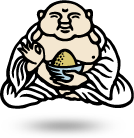
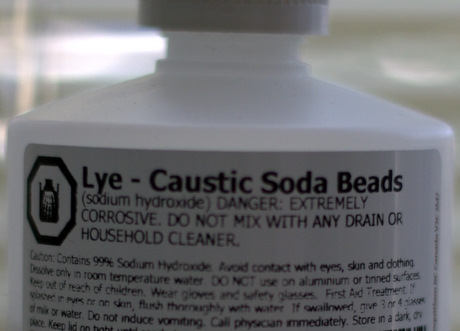
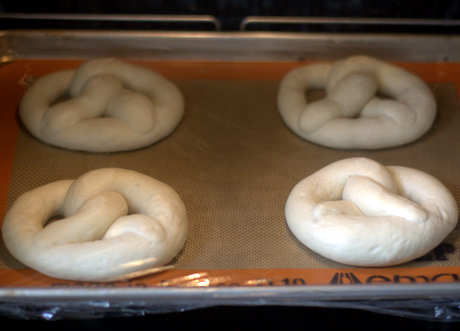
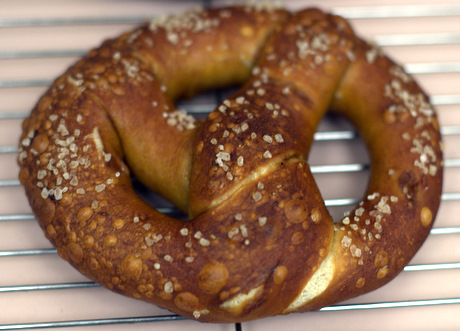
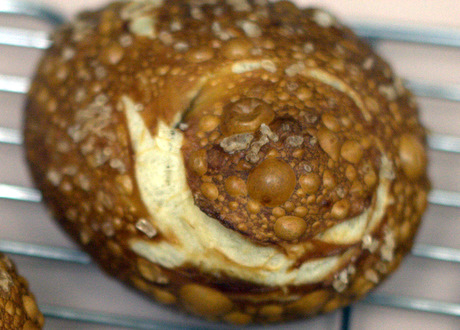

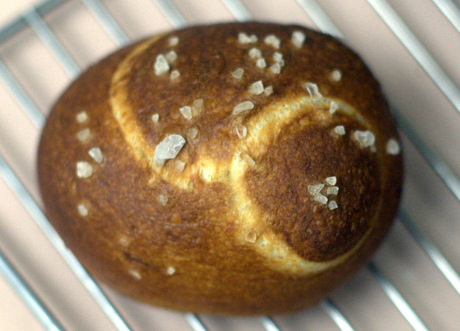
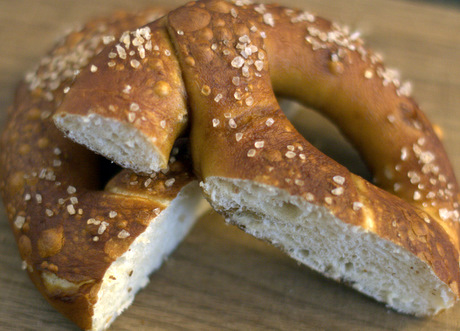

Posted on August 18th, 2010
Degan Beley says:
so rad. maybe when I get over my bread and cheese kick, I’ll give this a try.
Posted on July 11th, 2011
Bill_the_Baker says:
Dips in a Lye solution make the pretzels look and taste amazing! If your looking for a place to buy your Lye check out http://www.essentialdepot.com their prices are great, the Lye is pure and the bottles its packaged in make it easy to use and store!
Posted on August 10th, 2011
Bill_the_Baker says:
Hey everyone, just stoppin by again to share some more great news! Essential Depot is offering the first 300 customers a very special deal of only $2.94 for 2 lbs. of High Quality Food Grade Sodium Hydroxide Lye Micro Beads. Grab yours today by clicking on this link:
http://www.essentialdepot.com/servlet/the-2/2-lbs-Food-Grade/Detail
Posted on August 16th, 2011
Bill_the_Baker says:
hey everyone, im just stoppin in again to remind everybody to check out Essential Depot ( http://www.essentialdepot.com ) they’re selling High quality food grade Lye, 2lb’s for 3.44
Posted on August 18th, 2011
Bill_the_Baker says:
hey everyone, back once again with yet another update! Essential Depot is giving out the discount code “EDPC10” worth a 10% discount on your total order cost – including shipping and handling!
Posted on August 24th, 2011
Bill_the_Baker says:
heres another great pretzel recipe that i like, i tweaked it and made it a lil better! id love to share the finished product, unfortunately i cant but i can do the next best thing and share the recipe, so here ya go, ENJOY!
2 envelopes dry yeast
1 qt. milk, 2% is fine
1/2 c. warm water
3/4 c. shortening (I mix lard & butter & flavored Crisco)
1/2 c. sugar
1 1/2 tsp. baking powder
12 c. all-purpose flour, unsifted
1 1/2 tbsp. salt
Coarse salt to sprinkle
LYE DIP:
2 level tbsp. lye
2 quarts. cold water
Soften yeast in 1/2 cup water. Scald milk. Stir in shortening. Cool . Add yeast with 6 cups flour. Beat, vigorously. Cover, sit in warm place until risen , this takes just about 30 minutes.
Add remaining flour, baking powder, salt and sugar. Mix until well blended. Turn out on smooth surface. Cover with moist towel 3 minutes. Knead until elastic. Put in big kettle. Cover with towel. Put in warm place and Let rise until it has doubled in size, usually takes 1 1/2 hours. Punch dough down and let stand for 10 minutes. Cut into quarters then Cut quarters into 12 pieces. Cover with towel. Roll each piece into long strip for twisting. Place on stainless steel baking sheet, then put one at a time, pretzels on slotted, stainless steel lifter, dip very briefly in lye, usually a 3-5 second bath, drain on lifter and place back on sheet. As soon as cookie sheet is full, sprinkle with coarse salt. Bake in 400 degree oven until brown, about 15 minutes. Place on dry towel to cool. Cover twisted pretzels with towel until half raised.
IMPORTANT: Lye creates a volotile reaction with aluminum! aluminum sheets or dipping tool CANNOT BE USED. Also, I spray sheets with Pam, so there is no sticking.
Posted on December 26th, 2011
mlaiuppa says:
I just made Laugenbretzeln for the second time. (My Mom is German and longed for some traditional soft German pretzels).
My recipe only has a bit of sugar in the yeast mixture. The dough was just water, flour and salt. After kneading in the yeast mixture it rested. The second kneading I added butter and that’s it. Very simple ingredients but the result is oh so much more than just a pretzel shaped piece of bread.
After shaping they rested uncovered for an hour in the refrigerator so the surface could dry out a bit. Then they were dipped for 30 seconds, salted and slashed. Then they rested for another 15 min.
I made dough at 10:30 this morning and they came out of the oven at 2:30. But they are so delicious.
Respect the lye, but don’t be afraid of it. If you take common sense precautions (I took chemistry in high school) there is no reason to shy away from it. Not a project for children or to do if there are young children in the house. I kept a bottle of vinegar nearby in case of any accidents.
Posted on January 29th, 2014
Joe Blow says:
Hey Bill, ED doesn’t ship to Canada so stfu already. You spam every Canadian website and you assholes don’t even ship here so what’s the point.
Posted on March 16th, 2015
Manuela says:
Does anyone know where I can food grade Sodium hydroxide Lye for making Brezeln, Essentional Depot is not delivering to Canada?